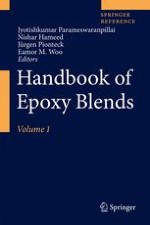2017 | OriginalPaper | Buchkapitel
27. pVT Analysis of the Effect of Addition of Thermoplastics, Block-Copolymers, or Rubbers on the Curing Behavior and Shrinkage of Epoxy Resins
verfasst von : Jürgen Pionteck
Erschienen in: Handbook of Epoxy Blends
Aktivieren Sie unsere intelligente Suche, um passende Fachinhalte oder Patente zu finden.
Wählen Sie Textabschnitte aus um mit Künstlicher Intelligenz passenden Patente zu finden. powered by
Markieren Sie Textabschnitte, um KI-gestützt weitere passende Inhalte zu finden. powered by
